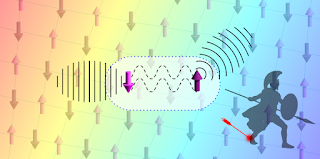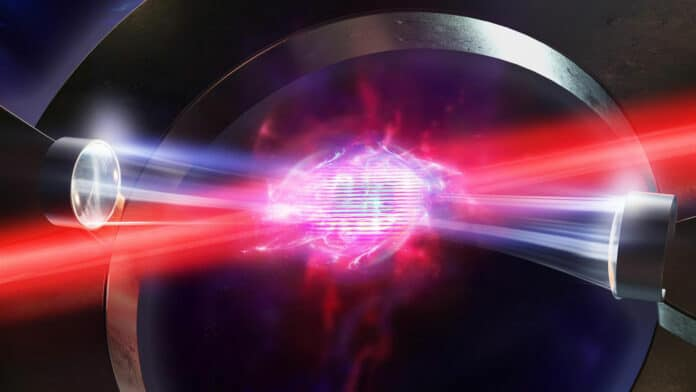Resolving the Achilles’ Heel of Thermal Hall Conductivity Measurements
For a long time, researchers assumed that phonons could not contribute to the thermal Hall effect because of their lack of charge and spin. New work challenges this assumption.
Figure 1: Only scattering processes that involve at least two (virtual) collisions with collective fluctuations can contribute to a Hall effect. Now researchers show that phonon scattering by a fluctuating quantum field meets this condition and leads to a phonon Hall effect. The results resolve the “Achilles’ heel” of thermal conductivity measurements.
How heat flows in interacting quantum many-body systems is one of the most interesting open problems in condensed-matter physics. Understanding thermal transport is particularly challenging in systems where charge-carrier contributions to energy transport are strongly suppressed, such as in insulators and superconductors. In such systems, heat transport cannot therefore be understood in terms of electronic carriers alone. In insulators, acoustic phonons are among the main energy carriers in an insulator. However, determining how and to what extent phonons contribute to heat transport in a material is the Achilles’ heel of interpreting thermal conductivity measurements. In particular, whether or not phonons can contribute to the thermal Hall effect—in which a temperature gradient in one direction produces heat flow in a perpendicular direction—remains an open question. Léo Mangeolle, of the École Normale Supérieure in Lyon, France, and his colleagues now propose an elegant theoretical framework to address this question . Their theory shows that a phonon Hall effect arises because of scattering of phonons by a fluctuating quantum field. The result provides a major step forward in our understanding of thermal transport in an important class of insulating materials.
In materials at low temperatures, thermal conductivity arises mainly from excitations that have a vanishingly small energy at long wavelengths. In magnetic insulators, these comprise various neutral excitations including collective low-energy modes, such as spin waves in ordered magnetic materials and neutral fermionic quasiparticles in quantum spin liquids. Acoustic phonons are another kind of low-energy mode associated with translational symmetry breaking in crystalline solids.
Condensed-matter theorists typically assume that the charge neutrality of phonons and the large masses of ions suffice to prevent these quasiparticles from coupling effectively to an external magnetic field. Therefore, any large thermal Hall response should mostly arise from electronic degrees of freedom. Many recent theoretical works have thus focused on thermal Hall conductivity from spin excitations . This assumption is, however, not universally justifiable. Recent experimental studies have shown that large thermal Hall conductivity can originate from phonons . Accordingly, these experiments pose the fundamental question of how lattice vibrations “sense” the time-reversal symmetry breaking of a magnetic field.
The main idea of Mangeolle and colleagues’ new study is that because electrons and ions form a coupled system, the phonon dynamics arise from time-reversal symmetry breaking in the electronic degrees of freedom—that is, from changes in electrons’ spin direction. The main challenge of this study was to unveil the mechanism by which time-reversal symmetry breaking and the resulting chirality gets communicated to the lattice. The team shows that this communication occurs via many-body scattering of phonons by a collective set of fields, dubbed Q fields, that describe low-energy electronic excitations that are directly affected by time-reversal symmetry breaking.
Combining quantum many-body theory with symmetry analysis, and guided by physical intuition, the authors developed a theory for the so-called skew scattering of phonons coupled to collective Q fields. This skew, or chiral, scattering involves collisions with the antisymmetric parts of the Q fields and gives rise to a phonon thermal Hall effect. By allowing the collective Q fields to be as general as possible, the authors presented a theory that can be applied to study thermal transport in a diverse set of electronic and magnetic phases.
The proposed theory comprises a hydrodynamic treatment of the nonequilibrium phonon distribution function in terms of Boltzmann’s equation. It computes the collision integral and the state transition rate—key quantities for describing the dynamics of a thermodynamic system with many possible states—under the assumption that phonon scattering occurs in a thermalized bath of collective Q fields. From these components, the researchers showed that the full scattering data needed to understand the thermal conductivity can be obtained from the time- and space-dependent correlation functions of these fields.
Remarkably, the standard two-point correlation function, which describes how two of the low-energy collective Q fields covary across space and time, gives vanishing contributions to the skew scattering and to the Hall effect. Instead, the skew scattering is proportional to a four-point correlation function of the fluctuating field. This means that the scattering can be attributed entirely to non-Gaussian fluctuations of these collective modes. This finding suggests that measurements of the thermal Hall effect could serve as a tool for studying higher-order correlations of collective Q modes. Such measurements could provide important information about the ground state of quantum materials.
The theory presented by Mangeolle’s team thus shows that the many-body scattering of phonons by collective mode fluctuations is ultimately what leads to a phonon Hall effect. An important direction for future research will be applying this theory to systems in which the thermal Hall conductivity cannot be explained by any neutral excitations of electronic origin. Perhaps such an approach will provide a viable theoretical explanation of observed transverse heat flows in terms of phonons.
#ThermalHallConductivityChallenges #MeasurementArtifacts #SampleQualityImprovement #TheoreticalModeling #CollaborativeResearch #StandardizationAndBenchmarking #InnovativeApproaches #MeasurementReliability #QuantifyingAnisotropy #ImpurityCharacterization




Comments
Post a Comment